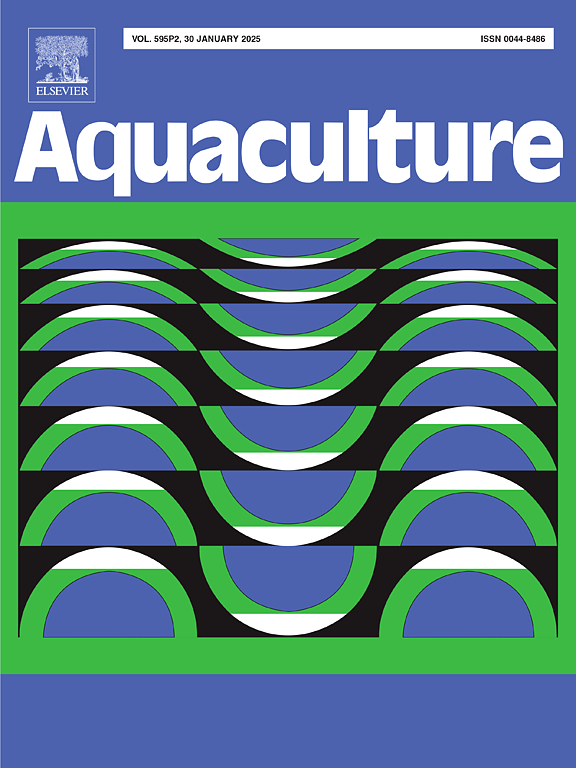探索缺氧引发的海参水肿:环境应激的分子视角
IF 3.9
1区 农林科学
Q1 FISHERIES
引用次数: 0
摘要
海岸带人类活动的加剧(如营养物污染、海岸带开发)和气候变化降低了水体溶解度,增强了水体分层,推动了全球缺氧带的扩大和加剧。当暴露在缺氧压力下时,一些海参会水肿(因液体过多而肿胀),更容易死亡。然而,水肿型海参与非水肿型海参在特定表型指标上的差异以及导致水肿的机制尚不清楚。在此,我们将具有生态价值的海参物种Apostichopus japonicus暴露于急性缺氧(2mg /L)环境中,以阐明其水肿的生理和分子机制。Apostichopus japonicus的经济效益为每年450亿美元。我们发现,常氧海参体壁重(Wbw)占湿重(Ww)的比例(53.49% ~ 53.80%)高于浮肿海参(43.32% ~ 44.80%),说明浮肿海参体内含有过多的海水,输送更多的氧气来应对缺氧。在呼吸树和管足中共同鉴定的上调mrna(如ficolin-2、金属蛋白酶抑制剂3样和补体成分C3)和下调mrna(如受体型酪氨酸蛋白磷酸酶epsilon、PR结构域锌指蛋白2和nlrc5样蛋白)至关重要。在水肿海参中,“辅助因子和维生素代谢”和“折叠、分选和降解”相关基因上调较多,“信号转导”和“免疫系统”相关基因下调较多。视黄醇代谢和磷脂酶D信号通路参与海参水肿的调节,但模式不同。总的来说,我们提供了对海参水肿的分子机制的见解,并有助于理解海参对未来日益缺氧的海洋的反应。本文章由计算机程序翻译,如有差异,请以英文原文为准。
Exploring hypoxia-triggered edema in sea cucumbers: Molecular perspectives on environmental stress
Intensified human activities in coastal zones (e.g. nutrient pollution, coastal development) and climate change reduce solubility and enhance water stratification, and have been driving the expansion and intensification of hypoxic zones globally. When exposed to hypoxic stress, some sea cucumbers become edematous (swollen with excessive fluid) and are more susceptible to mortality. However, the difference of specific phenotype indicators between edematous sea cucumber and non-edematous sea cucumber, and the mechanism underpinning edematous is not clear. Here, we exposed the ecologically valuable sea cucumbers species Apostichopus japonicus, which has an economic impact of >US$45 bn annually, to acute hypoxia (2 mg/L) to elucidate the physiological and molecular mechanisms which underpin edematous. We found that the percent of body wall weight (Wbw) in wet weight (Ww) was higher in normoxia sea cucumbers (53.49 %–53.80 %) than edematous sea cucumbers (43.32 %–44.80 %), indicating edematous sea cucumber contains excessive seawater inside the body to transport more oxygen to cope with hypoxia. The co-identified up-regulated mRNAs (i.e. ficolin-2, metalloproteinase inhibitor 3-like, and complement component C3) and down-regulated mRNAs (i.e. receptor-type tyrosine-protein phosphatase epsilon, PR domain zinc finger protein 2, and protein NLRC5-like) in both respiratory tree and tube foot were crucial. In edematous sea cucumbers, up-regulated genes were largely involved in “metabolism of cofactors and vitamins” and “folding, sorting and degradation,” while genes involved in “signal transduction” and “immune system” were largely down-regulated. Retinol metabolism and Phospholipase D signaling pathways participated in regulating sea cucumber edema but have varied patterns. Overall, we provide insights into the molecular mechanism underpinning sea cucumber edema and help to understand the response of sea cucumbers to increasingly oxygen-limited future oceans.
求助全文
通过发布文献求助,成功后即可免费获取论文全文。
去求助
来源期刊

Aquaculture
农林科学-海洋与淡水生物学
CiteScore
8.60
自引率
17.80%
发文量
1246
审稿时长
56 days
期刊介绍:
Aquaculture is an international journal for the exploration, improvement and management of all freshwater and marine food resources. It publishes novel and innovative research of world-wide interest on farming of aquatic organisms, which includes finfish, mollusks, crustaceans and aquatic plants for human consumption. Research on ornamentals is not a focus of the Journal. Aquaculture only publishes papers with a clear relevance to improving aquaculture practices or a potential application.
 求助内容:
求助内容: 应助结果提醒方式:
应助结果提醒方式:


